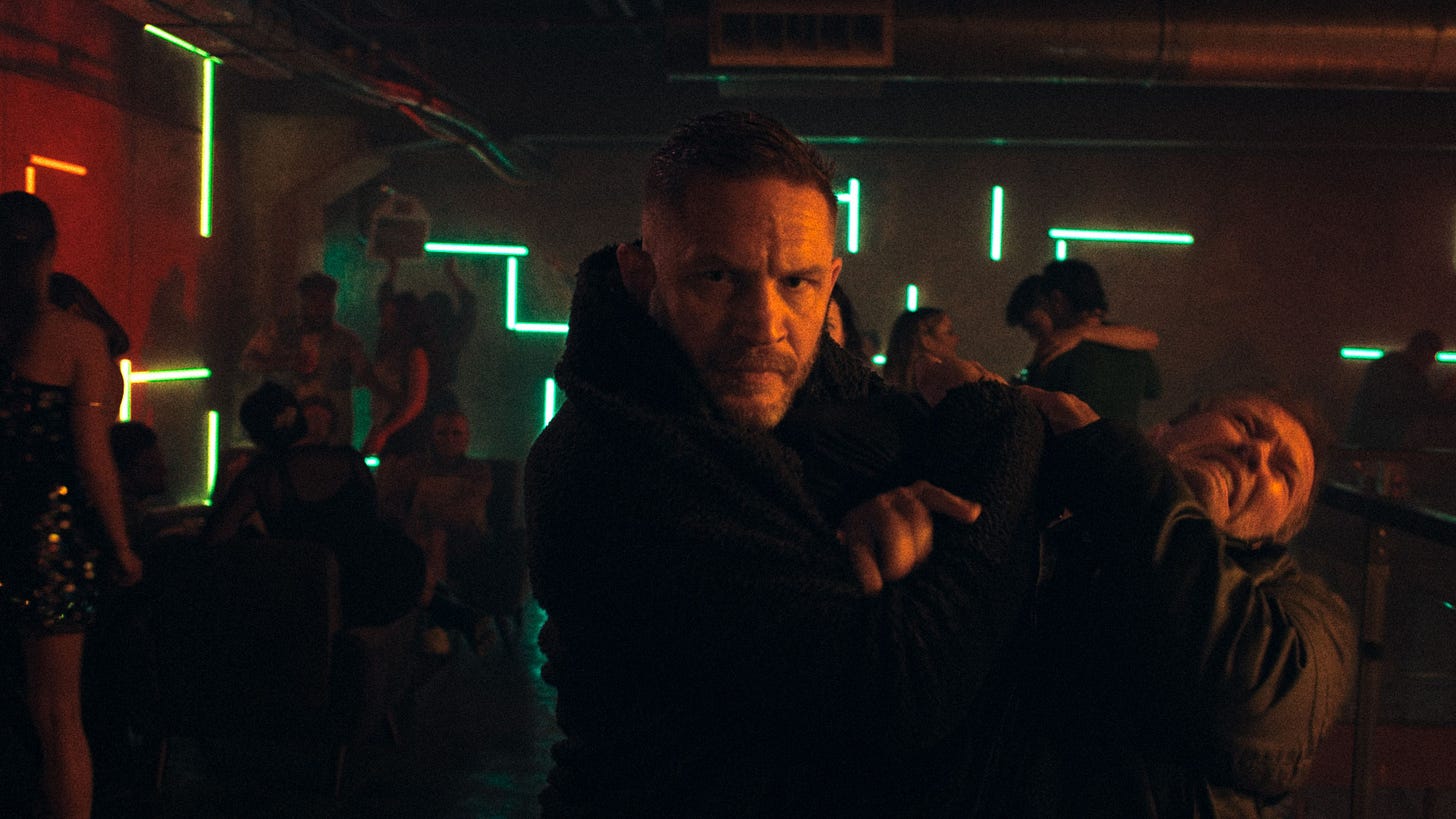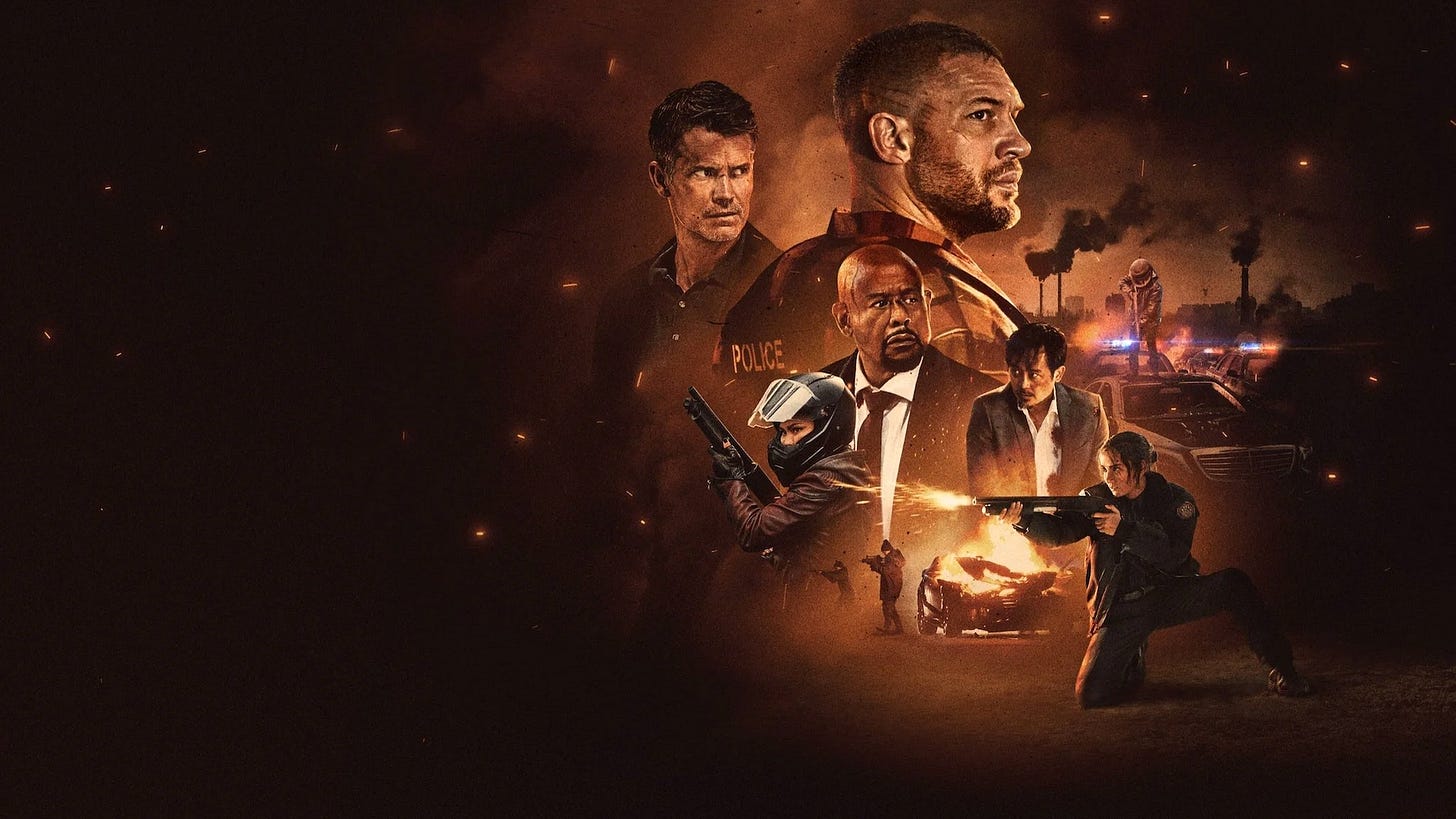The underwhelming HAVOC (2025) sees Netflix waste the talents of Tom Hardy and Gareth Evans
Also? WAY. TOO. MUCH. CGI.
“You live in this world, you make choices. Choices you try to justify. For yourself, for your family. And for a while, it works. Until it doesn't. Until you make a choice that renders everything worthless. One you can't justify. Can't forgive.”
Look at this. Look at how they (Netflix) massacred my boy (Gareth Evans)!
Never mind the convoluted-yet-generic crime saga plot that’s a cookie cutter carbon copy of a million other better and lesser movies that came before Havoc.
Never mind the predictable, dull-as-dishwater dialogue, and the two-dimensional stock character types populating the story like so much cardboard, which none of the actors can imbue with any life (though lord knows Tom Hardy, Forest Whitaker, and Luis Guzmán, et al., do try their hardest).
Never mind the main characters having the most absurd plot armour protecting them from hails upon hails of bullets, yet they can all hit their targets easily without getting hit once - not until the plot demands serious injury, anyway - which robs the film of the nail-biting sense of constant jeopardy and mortal danger Evans brought to his past action extravaganzas.
No, what I want to know is…
…why does it look like that?
Why is there so much obvious visual effects work, and so much shoddy green screen?
From the off, the film opens with an extended car chase that’s entirely rendered in CGI - the police cars and the truck they chase, the nighttime snow-covered roads and highways, the camera movements themselves, everything! It looks like the racing sequences in Ready Player One, only at least in Spielberg’s film it was supposed to look like a video game. Here in Havoc, it’s meant to have a real visceral kinetic energy of something like the car chases in The French Connection, To Live and Die in L.A., or hell, Bad Boys II, but it cannot possibly compare, because it all looks utterly weightless and unreal, like photo-real cutscenes rendered in Unreal Engine that nonetheless don’t feel real, for they just don’t have the sheer crunch and heft and power that practical stuntwork inherently would. (Y’know… like the stellar car chase Evans himself previously pulled off in The Raid 2!)
But it doesn’t stop there. This ungainly sheen of unconvincing VFX permeates the whole movie, sloppily slathered at any opportunity onto almost every sequence that takes place outside, including any time we’re shown the New York/Chicago-esque nameless city’s buildings and layout from a bird’s eye view, and whenever characters drive from place to place in front of poorly composited green-screened backgrounds. Even bloody Marvel would tell Havoc to tone it down with this VFX excess.
If the film was holistically one big hyper-stylised exercise in deliberately artificial digital spectacle - à la Sin City, Speed Racer, Sky Captain and the World of Tomorrow, or the Star Wars prequel trilogy - maybe then it could be forgiven. But given that this is a Gareth Evans joint, this overwhelming phoniness clashes significantly against the ethos of his established style: gritty, down-and-dirty, propulsive, and primarily practically-achieved action mayhem. Sure, there were plenty of CGI embellishments in his breakthrough film, The Raid, but nowhere near this extent.
The only reasons I can think of for this uncharacteristically heavy reliance on CGI are perhaps from a combination of reshoots Havoc went through after it initially wrapped in 2021 (according to IMDb trivia, so take that with a grain of salt), and the fact that this crime thriller, set in a generic corrupt American city with no name, was shot entirely in Evans’ home country of Wales, including in Swansea, and Cardiff - both cities that are literally only an hour-ish bus ride away from me. So I guess the makers of Havoc reckoned they could do what Doctor Who always does, and make Cardiff look like somewhere else through various purpose-built studio sets, and extensive CGI to fill in the larger outside world that can’t be depicted any other way.
Was the budget really that low that they couldn’t afford to shoot in a real American city, use real cars, shoot night scenes at night in real outside spaces, or any of the real tangible things that would give the film the verisimilitude it so often sorely lacks?
Look, it’s not all bad news. There are a couple of action sequences in the film’s back half - the one in the nightclub, and the one in the cabin - where Evans gets to do what he does best: crafting brutal and bloody scenes of exhilaratingly choreographed ultra-violence. Taken in isolation, they’re fine as standalone sequences that make you wish the rest of the film was anywhere near as good or engaging as those bouts of all-out carnage.
But alas, none of Havoc comes remotely close to reaching the heights of Evans’ past work, nor those of his contemporaries that emerged in the wake of the first Raid’s influential success (i.e. Chad Stahelski’s John Wick quartet; David Leitch’s Atomic Blonde; etc).
If you want to see Gareth Evans do this kind of film much better, both in terms of story and action, watch The Raid 2. And if you want to see Tom Hardy do this kind of character and story much better likewise, watch the Dennis Lehane-penned The Drop, which just so happened to come out the same year (2014) as The Raid 2. Either film is a better use of your time than watching Havoc.
A damn shame.






